Book contents
15 - Human and other problems
Published online by Cambridge University Press: 02 February 2010
Summary
A number of minor problems arise from consideration of the main issues under discussion above. They are not themselves part of the central argument, nor are they susceptible to logical ordering.
Authority. It has been suggested that it is presumptuous to publish without wide consultation an apparently iconoclastic scheme for handling primary information. Experience, however, over more than 25 years with the Botanical Code (ICBN) has been that only amendments to the Code with a narrow biological or a legalistic purpose could be contemplated; arrangements with a geologic or a wider general purpose were simply not understood enough to achieve serious discussion. Informal discussion on the zoological side (ICZN) about animal fossils indicated even greater rigidity. Since there has also been strong editorial bias towards complete acceptance of both Codes as central and mandatory in the field of fossils, it appears to be necessary to break with tradition. The only international organisation in this field, the International Palaeontological Association (IPA, originally IPU), has no mechanism and insufficient cohesion to accommodate such discussion; even as a member of its executive for a spell of four years I was quite unable to initiate within its scope any consideration of such matters at a Congress or otherwise. There is no other forum for paleontology as a whole, from which any authority might be sought; consequently normal scientific publication channels have to be used. The challenge therefore of PDHC is to advocate the restriction of both ICBN and ICZN to Holocene/Recent material, and also to recommend the re-writing of the International Stratigraphic Guide (Hedberg 1976) to about a quarter of its previous length and the removal of all reference therein to ‘classification’.
- Type
- Chapter
- Information
- Fossils as InformationNew Recording and Stratal Correlation Techniques, pp. 101 - 107Publisher: Cambridge University PressPrint publication year: 1989



